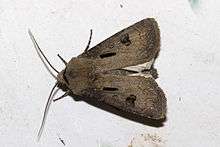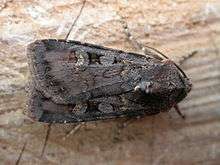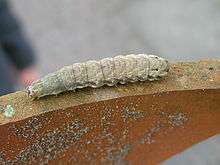Noctuinae
The Noctuinae are a subfamily of the family Noctuidae. The larvae of many species feed on roots or stems of various grasses. Some are generalist feeders which makes them potential pests.
| Noctuinae | |
|---|---|
 | |
| Heart and dart (Agrotis exclamationis) imago | |
| Scientific classification | |
| Kingdom: | Animalia |
| Phylum: | Arthropoda |
| Class: | Insecta |
| Order: | Lepidoptera |
| Superfamily: | Noctuoidea |
| Family: | Noctuidae |
| Subfamily: | Noctuinae |
| Tribes | |
| |
Noctuid systematics is in a state of flux; the list of tribes is provisional and other groups now considered more distinct (e.g. Hadeninae) were formerly included here. Likewise, the validity of the tribe Xestiini is doubtful for example.

Garden dart (Euxoa nigricans) imago

Double square-spot (Xestia triangulum) caterpillar

Eupsilia sp., early instar caterpillar
Genera
This subfamily provisionally contains these genera:
- Abagrotis
- Actebia
- Adelphagrotis
- Agnorisma
- Agrotis
- Albocosta
- Anagnorisma
- Anaplectoides
- Anicla
- Aplectoides
- Aseptis
- Axylia
- Basistriga
- Beriotisia
- Bifrontipta
- Blepharoa
- Brachypteragrotis
- Brachytegma
- Buciara
- Caphornia
- Cassania
- Cerastis
- Chamyla
- Chersotis
- Choephora
- Cladocerotis
- Claudaxylia
- Coenophila
- Copablepharon
- Crassivesica
- Cryptocala
- Cyrebia
- Dallolmoia
- Diarsia
- Dichagyris
- Dimorphinoctua
- Divaena
- Ectopatria
- Effractilis
- Eicomorpha
- Elegarda
- Engusanacantha
- Epilecta
- Epipsilia
- Episcotia
- Erebophasma
- Erythrophaia
- Estagrotis
- Estimata
- Euagrotis
- Eucoptocnemis
- Eueretagrotis
- Eugnorisma
- Eugraphe
- Euneophlebia
- Eurois
- Euxoa
- Euxoamorpha
- Euxootera
- Feltia
- Goniographa
- Graphiphora
- Grumia
- Hemieuxoa
- Hemiexarnis
- Hemigraphiphora
- Hemipachnobia
- Heptagrotis
- Hermonassa
- Hoeneidia
- Hyperfrontia
- Hypernaenia
- Ikondiana
- Isochlora
- Lycophotia
- Mabilleana
- Manruta
- Medlerana
- Ledereragrotis
- Loxagrotis
- Mentaxya
- Mesembragrotis
- Mesogona
- Metagnorisma
- Metalepsis
- Metecia
- Metopoplacis
- Micragrotis
- Micraxylia
- Naenia
- Netrocerocora
- Neurois
- Noctua
- Noctubourgognea
- Nyssocnemis
- Ochropleura
- Oligarcha
- Onychagrotis
- Opigena
- Oxytrypia
- Pachnobia
- Pachyagrotis
- Palaeagrotis
- Palaeamathes
- Parabagrotis
- Parabarrovia
- Paradiarsia
- Paradigma
- Paramathes
- Paraxestia
- Pareuxoa
- Parexarnis
- Peridroma
- Perissandria
- Petrowskya
- Phaenagrotis
- Praina
- Prognorisma
- Pronoctua
- Propatria
- Proragrotis
- Proteuxoa
- Powellinia
- Protexarnis
- Protognorisma
- Protogygia
- Protolampra
- Psaphara
- Psectraxylia
- Pseudohermonassa
- Pseudoleucania
- Pseudorthosia
- Pseudoseptis
- Pseudoxestia
- Raddea
- Rhizagrotis
- Rhyacia
- Rhynchagrotis
- Richia
- Schachowskoya
- Sclereuxoa
- Setagrotis
- Sineugraphe
- Sinognorisma
- Spaelotis
- Spinipalpa
- Standfussiana
- Stilbotis
- Subnoctua
- Synclerostola
- Tamseuxoa
- Tandilia
- Tesagrotis
- Tisagronia
- Tricheurois
- Trichophotia
- Trichosilia
- Tripseuxoa
- Turacina
- Uollega
- Vulcanica
- Xenophysa
- Xestia
References
- McLeod, Robin (July 3, 2012). "Subfamily Noctuinae - Cutworm or Dart Moths". BugGuide. Retrieved June 30, 2019.
| Wikimedia Commons has media related to Noctuinae. |
gollark: Well, the outsourced `parsedatetime` stuff can probably do it.
gollark: Good luck.
gollark: Fine.```python# from here: https://github.com/Rapptz/RoboDanny/blob/18b92ae2f53927aedebc25fb5eca02c8f6d7a874/cogs/utils/time.pyshort_timedelta_regex = re.compile("""(?:(?P<years>[0-9]{1,8})(?:years?|y))? # e.g. 2y(?:(?P<months>[0-9]{1,8})(?:months?|mo))? # e.g. 2months(?:(?P<weeks>[0-9]{1,8})(?:weeks?|w))? # e.g. 10w(?:(?P<days>[0-9]{1,8})(?:days?|d))? # e.g. 14d(?:(?P<hours>[0-9]{1,8})(?:hours?|h))? # e.g. 12h(?:(?P<minutes>[0-9]{1,8})(?:minutes?|m))? # e.g. 10m(?:(?P<seconds>[0-9]{1,8})(?:seconds?|s))? # e.g. 15s """, re.VERBOSE)def parse_short_timedelta(text): match = short_timedelta_regex.fullmatch(text) if match is None or not match.group(0): raise ValueError("parse failed") data = { k: int(v) for k, v in match.groupdict(default=0).items() } return datetime.datetime.utcnow() + relativedelta(**data)cal = parsedatetime.Calendar()def parse_humantime(text): time_struct, parse_status = cal.parse(text) if parse_status == 1: return datetime.datetime(*time_struct[:6]) else: raise ValueError("parse failed")def parse_time(text): try: return datetime.datetime.strptime(text, "%d/%m/%Y") except: pass try: return parse_short_timedelta(text) except: pass try: return parse_humantime(text) except: pass raise ValueError("could not parse time")```
gollark: ... no.
gollark: The time parsing logic is kind of inconsistent.
This article is issued from Wikipedia. The text is licensed under Creative Commons - Attribution - Sharealike. Additional terms may apply for the media files.
